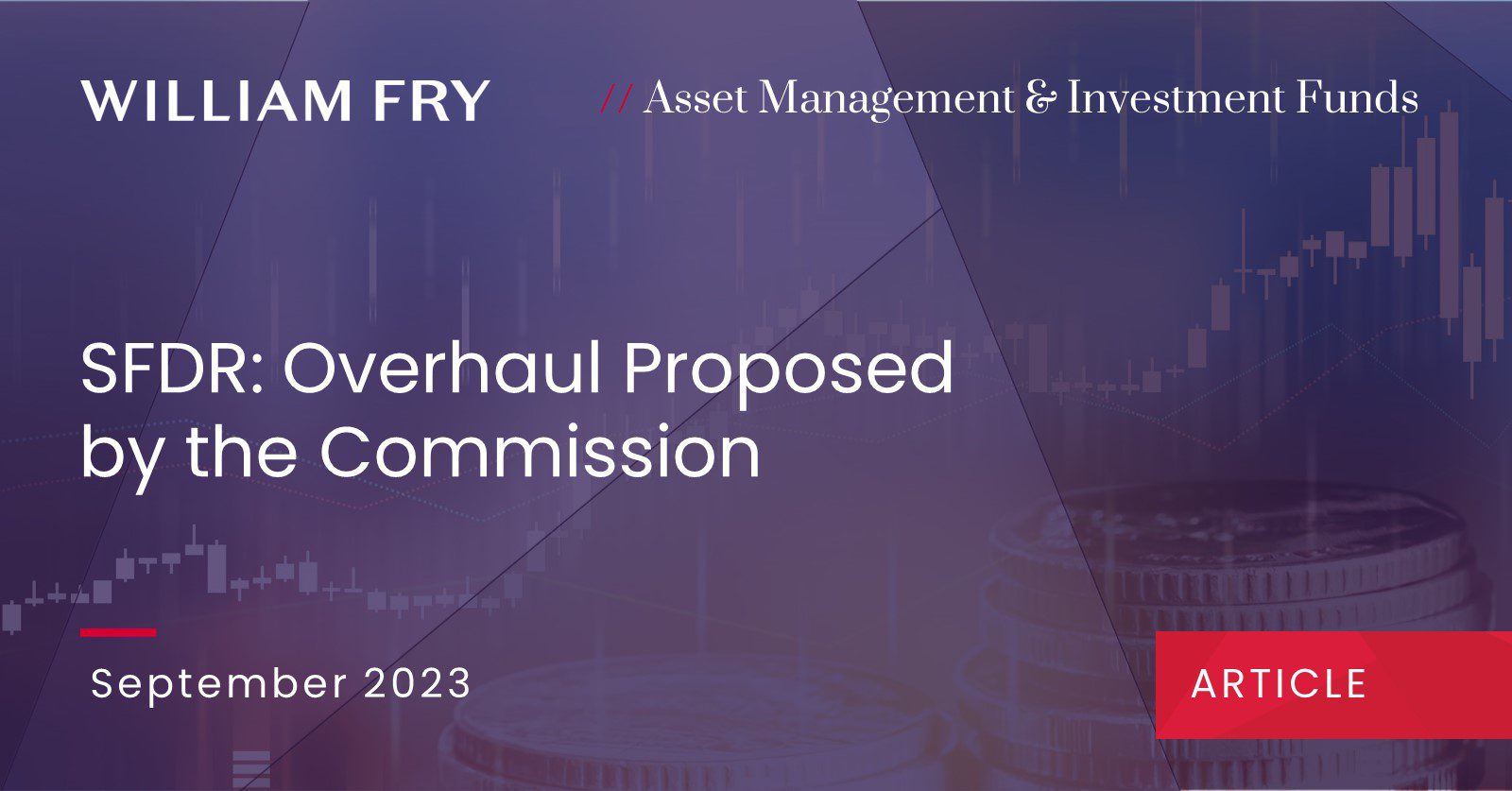The fast and challenging pace of EU sustainable finance policy continued last week with the publication of a Commission consultation on revisions to SFDR.
This is despite the regime only being fully effective from 1 January this year and the ongoing process to revise SFDR delegated measures (Level 2).
The consultation, which will run until 15 December 2023, takes the form of a request for feedback on many of the industry’s key SFDR compliance issues, including data gaps, legal uncertainty, greenwashing risks and the lack of focus on transition-based investment strategies within the regime.
Feedback is also sought on several, potentially highly impactful, reform proposals. These include the extension of the scope of product-level disclosure rules to encompass all products and the establishment of a sustainable product labelling regime to address policymakers’ long-held concerns about the use of Articles 8 and 9 as marketing tools.
The Commission expects to adopt SFDR proposals, taking account of consultation feedback, by Q2 2024.
Background
SFDR, the sustainability reporting regime for the financial services sector, was the first of a significant and ever-expanding set of EU sustainable finance policy measures. The regime mandates transparency of sustainability risk and impact management practices and sustainable product features to incentivise behavioural change within in-scope entities and to channel investment toward green and socially sustainable investments.
Since first entering into effect in March 2021, SFDR has presented a number of compliance challenges. These range from legal uncertainty, greenwashing and reputational risk due to the limited specificity in many of the key concepts, to data gaps due in part to the incoherence of the EU’s sustainable finance policy (which subjected the financial sector to transparency rules before obliging investee companies to make the necessary data available under corresponding EU transparency rules for the real economy).
As a result of these challenges, in tandem with the prominence of the sustainable finance policy on the EU agenda, the Commission is undertaking a ‘comprehensive assessment’ of the regime with a view to adopting new proposals in Q2 2024.
SFDR revisions under consideration by the Commission
The proposals tabled for industry feedback include a new EU sustainable product labelling regime, the streamlining of entity-level principal adverse impact (PAI) disclosures both within SFDR and across EU sustainable finance measures, and the application of SFDR product-level disclosures to all products and not just those with sustainability targets or features (as is currently the case). A summary of the key proposals is set out below.
1. Broadening the scope of product-level SFDR disclosure rules
Currently, most SFDR product-level rules are triggered by products’ disclosure of environmental or social characteristics or sustainable investment objectives. The Commission is considering broadening the scope of such product-level disclosures to require all products, or a subset of all products e.g., based on AUM or the proportion of retail products under management, to disclose ‘proportionate information on the sustainability profile’ regardless of the product’s sustainability claims. This could, in the Commission’s view, improve investor comparability of products and redress the balance of the disclosure burden which disproportionately rests with Article 8 and 9 products.
Based on the consultation questions, the Commission is considering requiring all/a subset of products to disclose a limited number of PAI indicators, any Taxonomy alignment levels, engagement strategies, exclusions, and/or information about ESG considerations in the investment process.
2. New labelling regime
Two options for a voluntary sustainable product labelling regime are under consultation. The first option is to establish labels based on products’ investment strategies and the second option is to build out the existing Articles 8 and 9 with further qualification criteria.
Potential labels under consideration for the first option are:
- For products investing in targeted, measurable solutions to sustainability issues e.g., investing in renewable energy, social housing or urban regeneration. This resembles the ‘sustainable impact’ label provided for under the FCA’s proposed UK SDR. See our previous briefing for further details of the FCA’s proposed UK SDR, final rules for which are expected to be published this year.
- For products adhering to credible sustainability standards or a specific sustainability-related theme e.g., investing in solid waste and water management companies or those with strong gender diversity levels within management. This resembles the ‘sustainable focus’ label under the FCA’s proposed UK SDR.
- For products excluding investment in activities with negative environmental or societal impacts.
- For products focussed on transition that target measurable improvements to the sustainability profile of assets under management e.g., investing in soon-to-be Taxonomy-aligned or transitional Taxonomy-aligned activities, entities with credible targets and/or plans to decarbonise, to improve workers’ rights, to reduce environmental impacts. This resembles the ‘sustainable improvers’ label under the FCA’s proposed UK SDR.
The Commission requests feedback on 1. – 4. and details of any other possible strategy-driven label. Questions are also raised on the utility of differentiating between 1. and 2. above and products with a social and environmental focus, the optimal number of labels, whether the labels should be mutually exclusive, any necessary transition measures, and what the minimum criteria for use of any label should be. Regarding minimum criteria, the Commission requests feedback on whether these should relate to Taxonomy-alignment levels, engagement strategies, exclusions, ESG considerations in the investment decision-making processes and/or pre-defined, measurable, positive environmental, social or governance-related outcomes.
The second option for a labelling regime is to build out the existing Articles 8 and 9 with clarification of, and the addition of minimum criteria for, the current concepts of ‘environmental/social characteristics’, ‘sustainable investments’, ‘contribution to an environmental/social objective’, ‘do no significant harm’ and ‘good governance practices’. Whether Articles 8 and 9 should apply a minimum level of Taxonomy-aligned investments is also raised in the consultation.
For both labelling regime options, consultation respondents are asked to opine on the merit of additional disclosures for those products opting into the labelling regime. Tabled for feedback are additional labelled product disclosures relating to the Taxonomy, engagement strategies, exclusions, satisfaction of labels’ minimum criteria and marketing materials including naming conventions. In addition, the Commission requests feedback on whether the use of a product label should be subject to third-party verification or if a self-declaration of satisfaction of the label’s minimum criteria should be sufficient. In terms of coherence of any labelling regime with other sustainable finance measures, respondents are asked whether the PRIIPs KID should include the label, whether the criteria for any forthcoming ESG benchmark should align with the minimum criteria for product labels, whether passive PAB/CTB trackers should be deemed to satisfy label criteria and whether MiFID sustainability preference rules should take account of the proposed labels.
3. Streamlining PAI indicators
The Commission is considering streamlining the PAI indicators in Annex I, Level 2 and requests feedback on which indicators respondents consider most and least useful.
Streamlining entity-level PAI disclosures across the various EU sustainable finance legislative measures is also under consideration with the consultation requesting feedback on whether SFDR is the correct measure for such disclosure rules given that they are also required under the soon-to-be effective Corporate Sustainability Reporting Directive (CSRD) and several sectoral ESG measures.
As previously briefed, PAI reporting under the CSRD is subject to a materiality assessment which allows in-scope entities to avoid reporting on PAI indicators self-assessed as non-material. SFDR differs from CSRD as it mandates use of a prescribed set of PAI indicators, with no option to omit indicators on a materiality basis. As data reported by investee companies under the CSRD is critical to compliance with SFDR PAI reporting, this discord between the regimes creates significant SFDR compliance challenges. In recognition of those challenges, the Commission requests feedback on whether all SFDR PAI indicators should, like CSRD, be subject to a materiality assessment by in-scope entities reporting PAIs on a mandatory or voluntary basis.
Next Steps
Feedback to the SFDR consultation is requested by 15 December 2023 and the Commission expects to adopt proposals, taking account of the feedback received, by Q2 2024.



